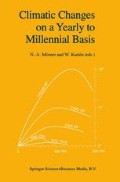Abstract
Palaeoecological studies based on analysis of pollen, plant macro-fossils and insect remains at a stratigraphic reference site, covering the time span 13,000–10,000 yrs B.P., in SW Sweden (Håkulls Mosse, province of Skåne) are interpreted against the two dominant palaeoclimatic models: the palaeobotanical model (Iversen) and the palaeoentomological model (Coope). An important time lag is found in the vegetation response to climatic improvement after deglaciation, which means that the biotic changes are best explained against the palaeoentomological model. This implies optimal summer temperatures 13,000–12,500 followed by a gradual deterioration until 11,000 when a sudden drop of temperature leads to a minimum between 11,000 and 10,500. A distinct rise of summer temperature around 10,500 is confirmed although the time lag in the vegetation response is ab. 300 years.
Access this chapter
Tax calculation will be finalised at checkout
Purchases are for personal use only
Preview
Unable to display preview. Download preview PDF.
References
Berglund, B.E., 1966. Late-Quaternary vegetation in eastern Blekinge, southeastern Sweden. A pollen-analytical study. I. Late-Glacial time. Opera Botanica 12, 1. 180 pp. Lund.
Berglund, B.E., 1971. Late-Glacial stratigraphy and chronology in South Sweden in the light of biostratigraphic studies on Mt. Kullen, Scania. Geologiska Föreningens i Stockholm Förh. 93, 11–45.
Berglund, B.E., 1979. The deglaciation of southern Sweden 13,500–10,000 B.P. Boreas 8, 89–118.
Birks, H.J.B., 1981. The use of pollen analysis in the reconstruction of past climates: a review. In: Wigley, T.M.L., Ingram, M.J. & Farmer, G. (eds.): Climate and History. Cambridge. 111–138.
Björck, S., 1981. A stratigraphic study of Late Weichselian deglaciation, shore displacement and vegetation history in south-eastern Sweden. Fossils and Strata 14. 93 pp.
Björck, S., 1984. Bio- and chronostratigraphic significance of the Older Dryas Chronozone — on the basis of new radiocarbon dates. Geologiska Föreningens i Stockholm Förh. 105, in print.
Björck, S. & Digerfeldt, G., 1984. Climatic changes at Pleistocene/ Holocene boundary in the Middle Swedish endmoraine zone, mainly inferred from stratigraphic indications. This volume.
Coope, G.R., 1975. Climatic fluctuations in northwest Europe since the Last Interglacial, indicated by fossil assemblages of Coleoptera. In: Wright, A.E. & Moseley, F. (eds.): Geol. Journ. Special Issue 6, 153–168.
Coope, G.R., 1977. Fossil coleopteran assemblages as sensitive indicators of climatic changes during the Devensian (Last) cold stage. Phil. Trans. R. Soc. Lond. B. 280, 313–340.
Coope, G.R. & Brophy, J.A., 1972. Late Glacial environmental changes indicated by a coleopteran succession from North Wales. Boreas 1, 97–142.
Davis, M.B., 1978. Climatic interpretation of pollen in Quaternary sediments. In: Walker, D. & Guppy, J.C. (eds.): Biology and Quaternary Environments. Austral. Acad, of Science, Canberra. 35–51.
Delcourt, H.R., Delcourt, P.A. & Webb, T., III, 1983. Dynamic plant ecology: The spectrum of vegetational change in space and time. Quaternary Science Reviews 1, 153–175.
van Geel, B. & Kolstrup, E., 1978. Tentative explanation of the Late Glacial and Early Holocene climatic changes in Northwestern Europe. Geologie En Mijnbouw 57, 87–89.
Iversen, J., 1954. The Late-Glacial flora of Denmark and its relation to climate and soil. Danm. Geol. Unders. II, 80, 87–119.
Iversen, J., 1973. The development of Denmark’s nature since the Last Glacial. Danm. Geol. Unders. V, 7 C. 126 pp.
Johansson, B., 1982. Deglaciationen av norra Bohuslän och södra Dalsland. Geol. inst., Chalmers tekn. högskola, Publ. A 38, 180 pp.
Kolstrup, E. & Buchardt, B., 1982. A pollen analytical investigation supported by an 180-record of a Late Glacial lake deposit at Graenge (Denmark). Rev. Palaeobot. and Palynol. 36, 205–230.
Lagerlund, E., 1980. Litostratigrafisk indelning av Västskänes Pleistocen och en ny glaciationsmodell för Weichsel. Univ. of Lund, Department of Quaternary Geology. Report 21, 120 pp.
Lagerlund, E., Knutsson, G., Amark, M., Hebrand, M., Jönsson, L.-O., Karlgren, B., Kristiansson, J., Möller, P., Robison, Ü.M., Sandgren, P., Terne, T. & Waldemarsson, D., 1983. The deglaciation pattern and dynamics in South Sweden, a preliminary report. Lund University, Department of Quaternary Geology, LUNDQUA Report 24, 7 pp.
Mangerud, J., 1980. Ice-front variations of different parts of the Scandinavian ice sheet, 13,000–10,000 years BP. In: Lowe, J.J., Gray, Ü.M. & Robinson, J.E. (eds.): Studies in the lateglacial of North-West Europe. Pergamon Press. 23–30.
Mangerud, J., Andersen, S.T., Berglund, B.E. & Donner, J.J., 1974. Quaternary stratigraphy of Norden, a proposal for terminology and classification. Boreas 3, 109–128.
Pennington, W., 1975. A chronostratigraphic comparison of Late-Weichselian and Late-Devensian subdivisions, illustrated by two radiocarbon-dated profiles from western Britain. Boreas 4, 157–171.
Pennington, W., 1977. The Late Devensian flora and vegetation of Britain. Phil. Trans. R. Soc. Lond. B. 280, 247–271.
Prentice, C, 1983. Postglacial climatic change: vegetation dynamics and the pollen record. Progress in Physical Geography 7, 273–286.
Rapp, A., 1982. Periglacial nivation cirques and local glaciations in the rock canyons of Söderasen, Scania, Sweden. A discussion and new interpretation. Geografisk Tidskrift 82, 95–98.
Usinger, H., 1981. Pollen- und Grossrestanalysen an limnischem Spätglazial aus dem Scharnhagener Moor, Schleswig-Holstein. Schr. Naturw. Ver. Schlesw.-Holst. 51, 85–105.
Author information
Authors and Affiliations
Editor information
Editors and Affiliations
Rights and permissions
Copyright information
© 1984 Springer Science+Business Media Dordrecht
About this chapter
Cite this chapter
Berglund, B.E., Lemdahl, G., Liedberg-Jönsson, B., Persson, T. (1984). Biotic Response to Climatic Changes during the Time Span 13,000–10,000 B.P. — a Case Study from SW Sweden. In: Mörner, NA., Karlén, W. (eds) Climatic Changes on a Yearly to Millennial Basis. Springer, Dordrecht. https://doi.org/10.1007/978-94-015-7692-5_3
Download citation
DOI: https://doi.org/10.1007/978-94-015-7692-5_3
Publisher Name: Springer, Dordrecht
Print ISBN: 978-90-481-8399-9
Online ISBN: 978-94-015-7692-5
eBook Packages: Springer Book Archive

